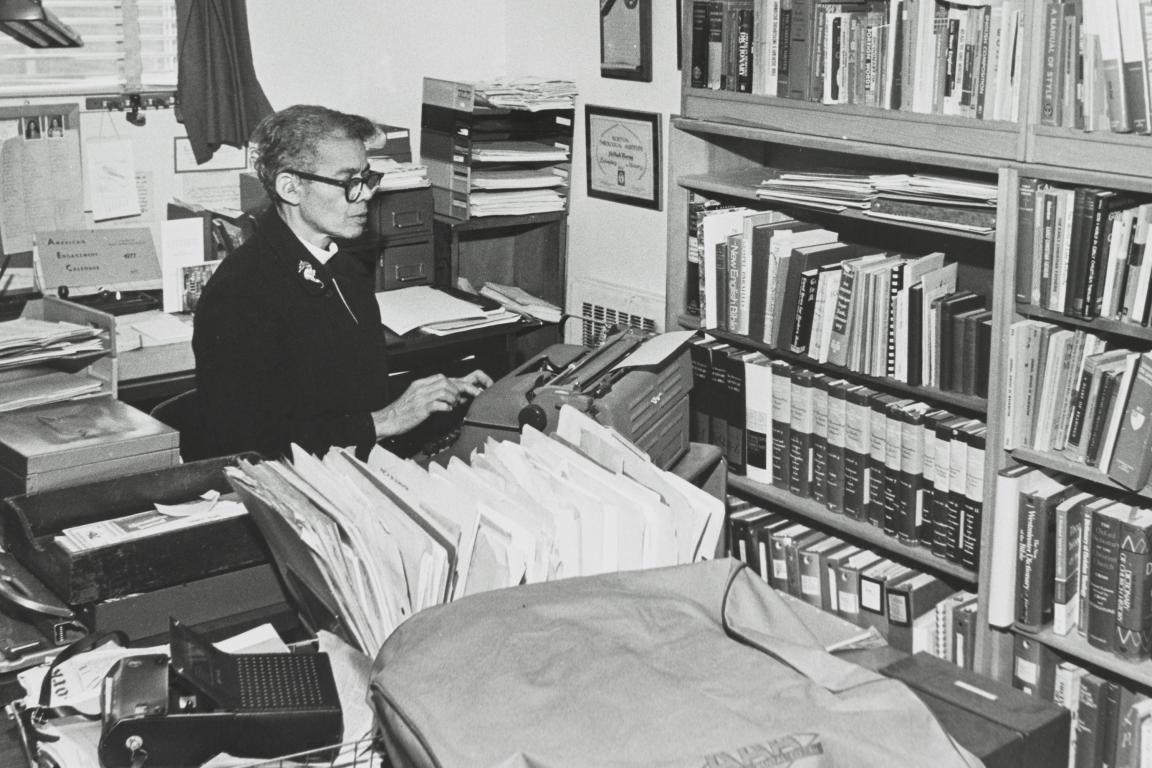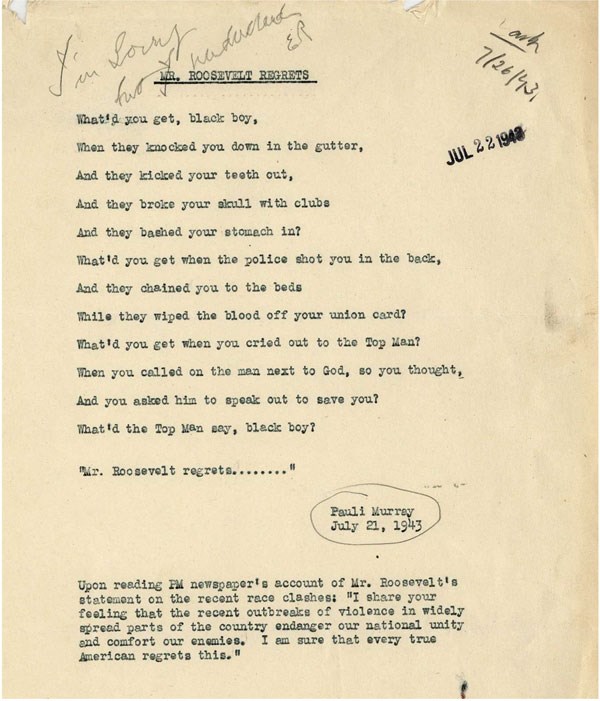
Pauli Murray in her study in Arlington, Virginia. Smithsonian National Museum of African American History and Culture. “We view your silence as a tacit political alliance with Southern reactionaries which may maintain the Democratic Party, but does not help democracy.”
Pauli Murray lived one of the most extraordinary and influential American lives of the twentieth century. In 1940, fifteen years before Rosa Parks, Murray was arrested for refusing to bend to Jim Crow bus laws. She led lunch counter sit-in protests at Howard University in 1943, seventeen years before the sit-ins in Greensboro, North Carolina, launched a national movement. Murray held a tenured professorship at Brandeis and taught in Ghana. She grappled with ideas about class, race, sexuality, and gender, politically and personally, publicly and privately. She co-founded the National Organization for Women and, in 1977, took perhaps her most dramatic career turn, becoming the first Black woman Episcopal priest. Murray was also a friend and frequent correspondent of Eleanor Roosevelt. She first encountered Eleanor Roosevelt in 1934, the year after earning her bachelor’s degree at Hunter College. Murray was living at Camp Tera (Temporary Emergency Relief Administration) in Bear Mountain, New York, established as part of the New Deal to offer housing for unemployed women. When ER visited, the shy Murray did not introduce herself, receiving a scolding from camp director Jessie Mills, who accused her of “obsequious behavior” and kicked her out of the camp after finding a copy of Das Kapital among her books. The next five years were difficult for Murray, who struggled with employment, poverty, her gender identity and sexuality, romantic relationships, and mental health. Her relationship with ER began in earnest in 1938, after FDR accepted an honorary doctorate at the University of North Carolina, which had denied Murray admission on account of her race. FDR called UNC a “liberal” institution, which incensed Murray, who decided to take the matter up with the president himself in a lengthy letter. “You called on Americans to support a liberal philosophy based on democracy. What does this mean for Negro Americans? Does it mean that we, at last, may participate freely, and on the basis of equality, with our fellow-citizens in working out the problems of this democracy. . . . Or does it mean, that everything you said has no meaning for us as Negroes, that again we are to be set aside and passed over for more important problems?” She copied ER, reminding her that “I was the girl who did not stand up when you passed through the Social Hall of Camp Tera during one of your visits in the winter of 1934–35.” To Murray’s surprise, ER took the letter seriously and used it as inspiration for a “My Day” article about justice and equality. By January 1940 Murray had become the executive secretary for National Sharecroppers Week, which aimed to raise awareness of the poor conditions of sharecroppers regardless of race and raise money for the union’s organizing efforts. NSW leaders hoped to persuade ER, who sympathized with impoverished farmers and in particular their vulnerable children, to host an essay contest and donate money. When Murray and her colleagues met with ER in her New York apartment, her “warmth was so embracing that I soon forgot the public personage and began to feel as if I might be talking with an affectionate older relative.” Roosevelt signed on in support of National Sharecroppers Week, and Murray felt “giddy with success.” Later that year ER was a key ally as Murray pursued the case of Odell Waller, an African American sharecropper who shot and killed his white landlord, Oscar Davis, for withholding his family share of the wheat crop, evicting family members, and other exploitative behavior. Murray and her allies, working with the Workers Defense League, argued that his crime was not premeditated and did not deserve the death sentence he received with his guilty verdict. What followed was a massive fundraising campaign, led by Murray, that enlisted the support of the NAACP and other labor and civil rights organizations. On November 20, 1940, Murray sent a letter to the first lady, explaining the case and asking for help. ER was sympathetic but feared anything that might upset white southern Democrats, and she was also conscious of FDR’s need for broad support for helping Great Britain in its war effort and did not want to create a distraction. By the summer of 1942, Murray had persuaded the first lady to join the campaign to lobby Virginia’s governor to grant clemency to Waller, a cause that had won the support of other liberal activists and intellectuals. Despite her initial reticence to openly align herself with the case, Roosevelt wrote to the new governor of Virginia, Colgate Darden, “I have had a great many letters about Odell Waller’s case, and the thing which impresses me is that one of the women who made the original investigation, writes me that she feels very strongly Odell Waller should not be executed. She begs me to ask you for clemency.” The woman to whom she referred was, of course, Murray. ER even tried to persuade her husband, but he was unconvinced, telling her not to speak publicly on the issue and that he “thought the Governor was acting entirely within his constitutional rights and, in addition to that, doubted very much if the merits of the case warranted the Governor’s reaching any other decision.” African American luminaries gathered at Madison Square Garden on June 16 for a “Save Odell Waller” rally. Twenty thousand people attended, mostly African American. A. Philip Randolph and Mary McLeod Bethune addressed the crowd, calling for justice for Waller and an end to the injustice of Jim Crow. Neither goal would be met. Although Darden granted Waller a reprieve in the aftermath of the rally, in the end, the governor concluded that Waller had had a fair trial by a fair and impartial jury. Pauli, Randolph, and Bethune attempted a last-minute meeting with the president at the White House to persuade him to intervene, but they were rebuffed. Waller was executed on July 2, 1942. A distraught Murray thanked ER: “Your compassion during those two trying hours on Wednesday night and the magnificent effort you put forth in behalf of our delegation made us know you were bearing our burden with us and softened the steel which entered our souls. All the members of the delegation feel the same way. You are a splendid American.” FDR, though, remained a target of her anger. As she wrote in an open letter to the president: “We view your silence as a tacit political alliance with Southern reactionaries which may maintain the Democratic Party, but does not help democracy. . . . The time will come when a Negro life will not be sacrificed on the altar of reactionary and behind-the-scene politics. As all Americans remember Pearl Harbor, Negro Americans will remember Odell Waller, and we solemnly pledge that he shall not have died in vain.” 
Franklin D. Roosevelt Presidential Library. When in June 1943, the president responded to the Detroit Race Riot by saying that uprisings “endanger our national unity and comfort our enemies,” Murray responded with one of her greatest poems, “Mr. Roosevelt’s Regrets,” published in the August 1943 issue of the Crisis. The title was a play on the Cole Porter song “Miss Otis Regrets,” and the poem remains as relevant now as it was then: What’d you get, black boy The relationship between Murray and ER deepened after the president’s death. “In spite of her crowded schedule,” Murray wrote in her memoir, “Mrs. Roosevelt found time to invite me to her New York apartment for tea or dinner once or twice a year, or for an occasional weekend at Val-Kill Cottage in Hyde Park, New York.” Murray believed that they both benefitted from these visits. “She liked having young friends around, and I think she admired and trusted my habit of not letting her high position prevent me from speaking out on a political issue when I disagreed with her. For me, these visits were like pilgrimages for renewal of the spirit. I sensed an unspoken spiritual bond between us, and I treasured them so much I could not bear to keep them all to myself.” _______________________
Explore the original report, The Roosevelts & African American Civil Rights Leaders, which features in-depth stories and additional leaders. DOWNLOAD THE REPORT |
Last updated: January 15, 2024
